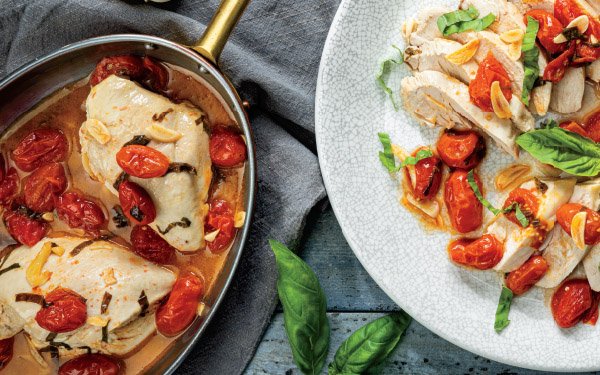
Cooking Class: Poaching & Simmering
Spice up routine mealtimes with poaching and simmering, two moist-heat cooking techniques that forgo fat and rely on liquids to cook foods. These easy methods provide healthy preparations for your favorite meals and work wonders for tenderizing ingredients. Experiment with these approaches to add dimension and adventure to your home cooking.
Poach Like a Pro
Poaching involves submerging food in liquid that’s 140° to 180° until the food is tender and cooked through. Water is most commonly used, but you can infuse flavor with anything from herbs and vegetables to vinegar, lemon juice or stock. Since poaching involves low temperatures and no agitation, it allows the ingredients to retain their nutrients and delicate items like fish and eggs to preserve their structures.
Best Foods for Poaching
• Eggs: Poaching gives eggs a soft, tender white and a creamy yolk. Add a splash of vinegar to the poaching water to hold the eggs together. To help the egg preserve its shape, crack it into a ramekin, then gently slide into the pan. Cook the egg for about 4 minutes, maintaining the heat, then remove with a slotted spoon and enjoy!
• Skinless Chicken Breasts: Poached chicken is juicy and succulent and only takes about 20 minutes to make. Use 2 cups of well-seasoned poaching liquid for every 4-5 ounce breast. Add poached chicken to salads, pastas or sandwiches, or try it in our Tomato-Garlic Poached Chicken recipe.
• Seafood: Poaching is an unintimidating way to prepare seafood. It’s great for salmon, tuna, halibut, cod and shellfish. Flavor the cooking liquid with salt, peppercorns and parsley, plus aromatics like onion, celery and garlic. Poach the fish for about 5 minutes for a tender, juicy entrée.
Simmer, Simmer Tasty Dinner
Simmering cooks foods in liquid low and slow at just below boiling, between 180° and 205°. Simmering is a bit more intense than poaching and requires a close watch. Bring water to a boil to ensure it’s come up to temperature, then lower to a simmer so only tiny bubbles remain. If you lose your simmer, get the temperature up without increasing the heat by covering the pot for a few moments. If the liquid begins to boil, pull the pot halfway off the burner until you’re back at a simmer.
Best Foods for Simmering
• Rice: To achieve a fluffy texture on this staple ingredient, use 2 cups of water for every 1 cup of rice. Simmer long-grain white rice for 18 minutes; short-grain white rice for 15 minutes; and brown rice for 45 minutes. Resist the urge to remove the lid while cooking, as the necessary hot air will escape. Trust the timing, and you’ll create beautifully fluffy, flavorful rice every time.
• Meats: Simmering tough cuts of meat, such as chuck roast, releases the fat and breaks down the collagen, producing tender, flavorful meat. Be sure to brown the meat first to enhance the texture, appearance and flavor, then simmer with a cooking liquid like broth or stock along with vegetables.
• Soups & Stews: Flavors develop the longer they simmer, making this an ideal method for soups and stews. Simply combine all of the ingredients, then let them simmer the day away. You’ll be rewarded with a rich, hearty soup or stew to warm you from the inside-out.
